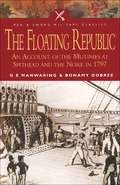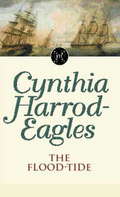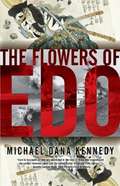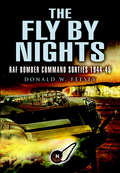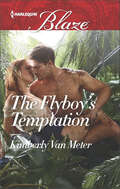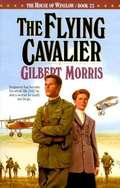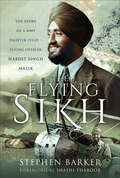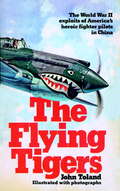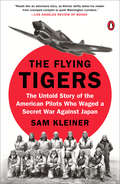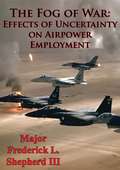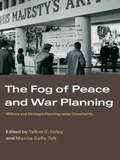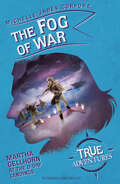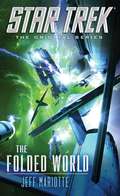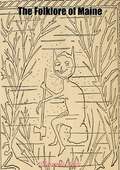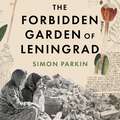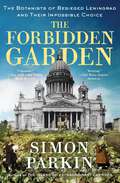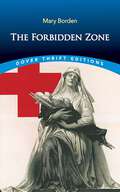- Table View
- List View
The Floating Republic: An Account of the Mutinies at Spithead and the Nore in 1797 (Pen & Sword Military Classics)
by Bonamy Dobree G.E. ManwaringThe naval mutiny of 1797 is the most astonishing recorded in British history; by its management rather than by its results. Though it shook the country, it was largely ordered with rigid discipline, a respect for officers and an unswerving loyalty to the King. Moreover, it was so rationally grounded that it not only achieved its immediate end, the betterment of the sailor's lot, but also began a new and lasting epoch in naval administration.
The Flood-Tide: The Morland Dynasty, Book 9 (Morland Dynasty #9)
by Cynthia Harrod-Eagles1772: Althought George III reigns over a peaceful England, his colonies in the Americas are claiming independence and a tide of revolutionary fervour is gripping France.Allen Morland and his beloved wife Jemimas work unstintingly to bring Morland Palace back to its former glory. Their seven children often bring them heartache, but they are sustained by their love of each other.The Mordland adventurer, Charles, emingrates to Maryland in persuit of the heiress Eugenie, but finds himself in the midst of the American claim for indepdence. Meanwhile, Henry, the family's bastard offshoot, pursues pleasure relentlessly but pennilessly until he finds a niche for himself in the fashionable Parisian salons, whilst outside revolution creeps closer...
The Flood-Tide: The Morland Dynasty, Book 9 (Morland Dynasty #9)
by Cynthia Harrod-Eagles1772: Although George III reigns over a peaceful England, his colonies in the Americas are claiming independence and a tide of revolutionary fervour is gripping France. Allen Morland and his beloved wife Jemimas work unstintingly to bring Morland Palce back to its former glory. Their seven children often bring them heartache, but they are sustained by their love of each other.The Mordland adventurer, Charles, emingrates to Maryland in persuit of the heiress Eugenie, but finds himself in the midst of the American claim for indepdence. Meanwhile, Henry, the family's bastard offshoot, pursues pleasure relentlessly but pennilessly until he finds a niche for himself in the fashionable Parisian salons, whilst outside revolution creeps closer.
The Flowers of Adonis
by Rosemary SutcliffA &“highly satisfactory&” historical novel portrays Alcibiades as &“magnetic, brilliant, often ruthless, restless, unable to accept a simple destiny&” (Kirkus Reviews). From the internationally acclaimed author of The Eagle of the Ninth . . . The epic story of Greece&’s most controversial hero. In the fifth century BC, against the background of perpetually warring Greek city-states, one man towered above the chaos. His name was Alkibiades. Friend of Socrates, sailor, warrior and incorrigible lover, he fled persecution in his native Athens to join her enemy: Sparta. However, his brilliant naval and diplomatic victories could not save him from the consequences of impregnating the Spartan queen, and once more he was forced to flee. Alkibiades settled into life as a roving soldier of fortune, though his love for Athens proved to be the overriding influence of his later life. When that glorious city eventually fell to the Spartans, his own violent demise was shortly to follow . . . &“A fascinating character study told with skill and erudition.&” —The Daily Telegraph &“A gripping story of battle, intrigue and ruin.&” —Evening Standard
The Flowers of Edo
by Michael Dana KennedyIn the climactic closing months of World War II, Allied Intelligence officers are summoned to the Malcañan Palace in Manila to be briefed by General MacArthur's Intelligence Staff on the optimal conclusion to the conflict in the Pacific Theater. Intelligence collected at the time concluded that the Americans had only three options to effectively force the Imperial Japanese Military into surrender: encirclement, blockade, and bombardment; isolating Japan from its forces in China, Korea, and Formosa; or engaging Japan through a full-scale amphibious invasion.In the debut novel by Michael Dana Kennedy, Japanese-American Lt. Ken Kobayashi must straddle a delicate line between duty to country and honor to his family as he is assigned by General MacArthur to infiltrate the Imperial Japanese Army in the lead-up to an invasion of the Japanese archipelago. From the deck of the U.S.S. Yorktown to the halls of the Imperial Ministry of War in Ichigaya in Tokyo, The Flowers of Edo reveals the intricacies of the military machine and the human and cultural price that was paid in the bombings on Japan through a perspective never before seen in fiction. Meticulously researched and endorsed by military insiders and historians from both sides of the Pacific, Lt. Kobayashi's tale of espionage and romance will shed new light on what might have happened.
The Flowers of the Forest: Scotland and the First World War
by Trevor RoyleThe author of Culloden details the effects of World War I on Scotland. On the brink of the First World War, Scotland was regarded throughout the British Isles as &“the workshop of the Empire.&” Not only were Clyde-built ships known the world over, Scotland produced half of Britain&’s total production of railway equipment, and the cotton and jute industries flourished in Paisley and Dundee. In addition, Scots were a hugely important source of manpower for the colonies. Yet after the war, Scotland became an industrial and financial backwater. Emigration increased as morale slumped in the face of economic stagnation and decline. The country had paid a disproportionately high price in casualties, a result of huge numbers of volunteers and the use of Scottish battalions as shock troops in the fighting on the Western Front and Gallipoli—young men whom the novelist Ian Hay called &“the vanished generation.&” In this book, Trevor Royle provides the first full account of how the war changed Scotland irrevocably by exploring a wide range of themes: the overwhelming response to the call for volunteers; the performance of Scottish military formations in 1915 and 1916; the militarization of the Scottish homeland; the resistance to war in Glasgow and the west of Scotland; and the boom in the heavy industries and the strengthening of women&’s role in society following on from wartime employment. &“Royle has done First World War History a great service.&” —Gary Sheffield, military historian &“His exceptional talents at narration produce a work that is both through-provoking and engaging . . . A vivid, solidly-written book.&” —International Review of Scottish Studies
The Fly By Nights: RAF Bomber Command Sorties 1944–45
by Donald W. FeeseyAt the age of eighteen Don Feesey volunteered for pilot training with the RAF. Having almost completed his course to become a fighter pilot, an eye problem was detected and he was switched to navigational training. He completed a tour of thirty-four successful operations, the majority at night during 1944 and 1945 at the height of the bomber offensive. On one remarkable sortie his Lancaster lost all power and the order to bale out was given. As the aircraft gradually lost altitude, making a safe parachute descent more impossible by the second, Don was about to jump when the pilot, still at the controls, attracted his attention. It was a life or death situation. Should he jump or go to the assistance of his pilot, leading to an almost certain death? He elected to go to the aid of what he thought was his trapped pilot but to his astonishment he found that the skipper had nursed one engine back into life, so the only two remaining crew managed to struggle back across the Channel, only to find that at 700feet they could not climb over the usually welcome white cliffs of Dover. They turned for Manston, the nearest airfield and flew along the coastline to make an eventual safe landing.
The Fly Girls Revolt: The Story of the Women Who Kicked Open the Door to Fly in Combat
by Eileen A. BjorkmanThis is the untold story of the women military aviators of the 1970s and 1980s who kicked open the door to fly in combat in 1993—along with the story of the women who paved the way before them.In 1993, U.S. women earned the right to fly in combat, but the full story of how it happened is largely unknown. From the first women in the military in World War II to the final push in the 1990s, The Fly Girls Revolt chronicles the actions of a band of women who overcame decades of discrimination and prevailed against bureaucrats, chauvinists, anti-feminists, and even other military women. Drawing on extensive research, interviews with women who served in the 1970s and 1980s, and her personal experiences in the Air Force, Eileen Bjorkman weaves together a riveting tale of the women who fought for the right to enter combat and be treated as equal partners in the U.S. military. Although the military had begun training women as aviators in 1973, by a law of Congress they could not fly in harm&’s way. Time and again when a woman graduated at the top of her pilot training class, a less-qualified male pilot was sent to fly a combat aircraft in her place. Most of the women who fought for change between World War II and today would never fly in combat themselves, but they earned their places in history by strengthening the U.S. military and ensuring future women would not be denied opportunities solely because of their sex. The Fly Girls Revolt is their story.
The Flyboy's Temptation
by Kimberly Van MeterRisky business... A redhead with long legs, creamy kissable skin and a big fat wad of cash? That's the kind of trouble former Air Force pilot J. T. Carmichael can't resist. With his charter flight business on the verge of bankruptcy, J.T. can't afford to say no to the money or the uniquely sexy woman who needs to get to South America immediately. Until the bullets start flying... When his plane goes down somewhere in the Mexican jungle, J.T. realizes two things: (1) he might not make it out alive, and (2) he wants Hope Larsen something fierce. Stranded and fighting for their lives, neither Hope nor J.T. can avoid the inevitable rush of pure, heated lust. Now this flyboy isn't just flying in the face of danger...he's sleeping with her.
The Flying Cavalier (House of Winslow, #23)
by Gilbert MorrisWhen his wife is killed during German bombardment, RAF pilot Lance Winslow vows revenge. Logan Winslow from America comes with his friend, Revelation Brown to fight in World War I.
The Flying Grunt: The Story of Lieutenant General Richard E. Carey, United States Marine Corps (Ret)
by Alan E. MeschesInspiring story of a young man from a humble background who received the Bronze and Silver Star for service as a Marine in Korea, including fighting at the Chosin Reservoir, and was almost selected as an astronaut.Richard Edward Carey came from a broken home. Enlisting in the Corps in 1946 he later earned a commission, fighting at Inchon and Chosin in Korea before becoming a pilot—flying every aircraft in the Marine arsenal. During his 38-year military career he witnessed and participated in major historical events, though a high school wrestling injury would eliminate him from the Mercury-7 space program. As a second lieutenant, he tackled General Douglas MacArthur on the way to Seoul in 1950. Carey would provide critical intelligence decisions enabling the successful defense of the Chinese attack on Hagaru-ri at the Chosin Reservoir. In 189 days of combat, he escaped death seven times, and was awarded the Silver Star and Bronze Star Medals. In Vietnam, he flew 204 combat sorties, earning the Distinguished Flying Cross and 16 Air Medals. In 1975, from Saigon, Carey led history’s largest helicopter evacuation of refugees. Subordinates praised his leadership and courage. Never afraid to stand up for his principles, Carey faced down an Air Force general in Vietnam, and organized air defense for supply helicopters at Khe Sahn; he countermanded a senior Naval officer’s order during the 1975 Saigon evacuation, refusing to cease air operations and forcing a reluctant ambassador onto a flight. In retirement, Carey served as a cabinet member for the governor of Ohio and ran the airport in his native home of Columbus. When the Careys moved to Texas, Carey continued supporting veterans, advocating for veterans’ health care, aiding the drive to build accommodation for families of hospitalized veterans, and was a leader in the effort to build a veterans’ cemetery in Dallas. He would lead the drive to build two Chosin Few memorials even as he cared for his ailing wife. This biography is based upon hours of interviews with the general, his papers, speeches, and Marine Corps documents that captured an exceptional and inspiring life.
The Flying Sikh: The Story of a WW1 Fighter Pilot—Flying Officer Hardit Singh Malik
by Stephen BarkerThe Flying Sikh tells the unique story of the only Sikh airman to fly with the RFC and the RAF during the First World War. It is the remarkable account of one man’s struggle to enlist, against discrimination, and then his service as a fighter pilot over the battlefields of Flanders. This book represents the only detailed study of an Indian national enlisting in Britain’s armed forces during the First World War. It is an account of India’s role in the war; the rise of Indian nationalism and the challenges of Indians to take up the status of a commissioned officer in His Majesty’s Armed Forces. Malik started his new life in Britain as a fourteen-year-old public school boy, who progressed to Balliol College, Oxford, before attempting to join the Royal Flying Corps after graduation with friends from university, but was denied a commission. Keen to participate in the war, he served with the French Red Cross in 1916 as an ambulance driver and then offered his services to the French air force. Ultimately, one of his Oxford tutors wrote on Malik’s behalf to General David Henderson, the former head of the RFC, and secured Malik a cadetship Above all though, it is the story of a man who was a county cricketer who played for Sussex and Oxford University, an outstanding golfer and fighter pilot who fought over Passchendaele in the autumn of 1917. Being a devout Sikh, he wore a specially designed flying helmet that fitted over his turban. Malik claimed two kills until he was shot down, crashing unconscious to the ground behind Allied lines. His Sopwith Camel was riddled with over 400 bullet holes. Malik was only one of a small number of Indian nationals who served with the RAF during the war. In later life, Malik became the first Indian High Commissioner to Canada, and then served as the Indian Ambassador to France.
The Flying Tigers
by John TolandDuring World War II, a group of American fighter pilots roamed the skies over China and Burma, menacing the Japanese war effort without letup. Flamboyant, daring, and courageous, they were called the Flying Tigers. The Tigers, who had been recruited from the Army, Navy, and Marines, first saw action as a volunteer group fighting on the side of the Chiang Kia-shek's China against Japan. Trained in the unconventional air-combat tactics of their maverick leader Claire Lee Chennault, they racked up some of the most impresive air victory records of World War II. This is the story of Chennault and his magnificent Tigers -- and how they performed the impossible.
The Flying Tigers: The Untold Story of the American Pilots Who Waged a Secret War Against Japan
by Sam KleinerThe thrilling story behind the American pilots who were secretly recruited to defend the nation’s desperate Chinese allies before Pearl Harbor and ended up on the front lines of the war against the Japanese in the Pacific Sam Kleiner’s The Flying Tigers uncovers the hidden story of the group of young American men and women who crossed the Pacific before Pearl Harbor to risk their lives defending China. Led by legendary army pilot Claire Chennault, these men left behind an America still at peace in the summer of 1941 using false identities to travel across the Pacific to a run-down airbase in the jungles of Burma. In the wake of the disaster at Pearl Harbor this motley crew was the first group of Americans to take on the Japanese in combat, shooting down hundreds of Japanese aircraft in the skies over Burma, Thailand, and China. At a time when the Allies were being defeated across the globe, the Flying Tigers’ exploits gave hope to Americans and Chinese alike. Kleiner takes readers into the cockpits of their iconic shark-nosed P-40 planes—one of the most familiar images of the war—as the Tigers perform nail-biting missions against the Japanese. He profiles the outsize personalities involved in the operation, including Chennault, whose aggressive tactics went against the prevailing wisdom of military strategy; Greg “Pappy” Boyington, the man who would become the nation’s most beloved pilot until he was shot down and became a POW; Emma Foster, one of the nurses in the unit who had a passionate romance with a pilot named John Petach; and Madame Chiang Kai-shek herself, who first brought Chennault to China and who would come to visit these young Americans. A dramatic story of a covert operation whose very existence would have scandalized an isolationist United States, The Flying Tigers is the unforgettable account of a group of Americans whose heroism changed the world, and who cemented an alliance between the United States and China as both nations fought against seemingly insurmountable odds.
The Fog Of War: Effects Of Uncertainty On Airpower Employment
by Major Frederick L. Shepherd IIIThis paper addresses the question: Can fog be identified from past air campaigns and applied to make future air combat more effective? The purpose is to educate the reader on fog and to offer techniques for coping with fog in future air combat. The paper is divided into three sections: Defining fog; presenting examples of fog from the air campaigns of World War II Europe and the Persian Gulf War; and recommending ways to cope with it.This paper defines fog as uncertainty about the enemy, the environment, and friendly forces. Examples will illustrate these uncertainties so the reader can learn to identify uncertainty in the air combat environment. The paper concludes with an analysis of uncertainty, along with recommendations for coping with uncertainty in the employment of airpower. These recommendations are under the five general areas of technology, leadership, training, experience, and planning.The author believes that the key to coping with uncertainty is to understand it. Thus, the airpower practitioner needs to know what uncertainty is, what it looks like, and how to avoid it, or at least minimize its adverse impacts.
The Fog of Peace and War Planning: Military and Strategic Planning under Uncertainty (Strategy and History #Vol. 12)
by Monica Duffy Toft Talbot C. ImlayHow do we plan under conditions of uncertainty? The perspective of military planners is a key organizing framework: do they see themselves as preparing to administer a peace, or preparing to fight a future war? Most interwar volumes examine only the 1920s and the 1930s. This new volume goes back, and forward in time, to draw on a greater expanse of history in order to tease out lessons for contemporary planners.These chapters are grouped into four periods: 1815-1856, 1871-1914, 1918-1938, and post-Second World War. They progress from low-tech to high-tech concerns, for example, the first period examines armies, while the second period examines navies, the third asseses navies combined with air forces, and finally for the Kaiser chapter explores nuclear issues and decision-making.
The Fog of War
by Mark BourrieThe Canadian government censored the news during World War II for two main reasons: to keep military and economic secrets out of enemy hands and to prevent civilian morale from breaking down. But in those tumultuous times - with Nazi spies landing on our shores by raft, U-boat attacks in the St. Lawrence, army mutinies in British Columbia and Ontario and pro-Hitler propaganda in the mainstream Quebec press - censors had a hard time keeping news events contained.Now, with freshly unsealed World War II press-censor files, many of the undocumented events that occurred in wartime Canada are finally revealed. In Mark Bourrie's illuminating and well-researched account, we learn about the capture of a Nazi spy-turned-double agent, the Japanese-Canadian editor who would one day help develop Canada's medicare system, the curious chiropractor from Saskatchewan who spilled atomic bomb secrets to a roomful of people and the use of censorship to stop balloon bomb attacks from Japan. The Fog of War investigates the realities of media censorship through the experiences of those deputized to act on behalf of the public and reveals why press censorship in wartime Canada was, at best, a hit-and-miss game.
The Fog of War: Martha Gellhorn at the D-Day Landings (True Adventures)
by Michelle Jabes CorporaThe inspiring true story of Martha Gellhorn's perilous, secret journey to become the only female journalist to cover the D-Day landings of 1944THE ENGLISH CHANNEL. JUNE 1944. On a dark night at the height of World War Two, thousands of ships charge across the ocean towards the French coast. This is Operation Neptune: the beginning of the fight to free Europe from the Nazis. The next few weeks will turn the tide of the war. On board one of the hospital ships, disguised as a nurse, is Martha Gellhorn. A seasoned war correspondent, she talked her way onboard, hiding in a lavatory until it was too late to send her back. Now Martha is on her way to make history as the only woman to set foot on the beaches on D-Day.
The Folded World: The Folded World (Star Trek: The Original Series)
by Jeff MariotteAn original novel set in the universe of Star Trek: The Original Series!En route to a diplomatic mission, the U.S.S. Enterprise receives a distress call from the U.S.S. McRaven. As the Enterprise approaches the area where the McRaven appears to be, Captain James T. Kirk and his crew encounter an anomaly unlike anything they’ve ever experienced. Space itself seems inconsistent here . . . warping, changing appearance. But during the brief periods of calm, the McRaven is located along with other ships of various origins—all dead in space and devoid of any life forms, all tightly surrounding and being held in place by an enormous unidentified vessel that appears to have been drifting for a millennium. As incredible and impossible as it seems, this anomaly is something that can only be described as a dimensional fold, a place where the various dimensions that science has identified—and the ones it cannot yet name—have folded in on one another, and the normal rules of time and space no longer apply. . . .
The Folding Knife
by K. J. ParkerBasso the Magnificent. Basso the Great. Basso the Wise. The First Citizen of the Vesani Republic is an extraordinary man. He is ruthless, cunning, and above all, lucky. He brings wealth, power and prestige to his people. But with power comes unwanted attention, and Basso must defend his nation and himself from threats foreign and domestic. In a lifetime of crucial decisions, he's only ever made one mistake. One mistake, though, can be enough.
The Folklore of Maine
by Horace P. Beck“THIS is not a scholarly book in the pedantic sense nor is it intended to be one. Neither is it a complete collection of Maine folklore. Rather, it is a selection of tales, beliefs, superstitions, songs, and customs of people of English-speaking stock in Maine. It is a book that attempts to give illustrations of most of the major aspects of folklore that are, or have been within the last twenty years, extant in the state.”—Horace P. Beck, Introduction“There is no dearth of folklore in the little state of Maine. This book has placed some important examples of folklore into their historical contexts. A diversified sampling is given and we are surprised to learn how much of folklore is a disguise or an exaggeration of the real past.”—Kirkus Review
The Forbidden Garden of Leningrad: A True Story of Science and Sacrifice in a City under Siege
by Simon ParkinFrom the winner of the 2023 Wingate Literary Prize comes a fascinating and moving untold story of the Leningrad scientists who risked everything for the future of humanity"An astonishing story brilliantly told... It is as moving as it is gripping to read"Jonathan Dimbleby, author of Endgame: 1944"A gripping, original and important story of courage and science in wartime" Roland Philipps, author of A Spy Named OrphanIn the summer of 1941, German troops surrounded the Russian city of Leningrad - now St Petersburg - and began the longest blockade in recorded history. By the most conservative estimates, the siege would claim the lives of three-quarters of a million people. Most died of starvation.At the centre of the embattled city stood a converted palace that housed the greatest living plant library ever amassed - the world's first seed bank. After attempts to evacuate the collection failed, and as supplies dwindled, the scientists responsible faced a terrible decision: should they distribute the specimens to the starving population, or preserve them in the hope that they held the key to ending global famine?Drawing on previously unseen sources, The Forbidden Garden tells the remarkable and moving story of the botanists who remained at the Plant Institute during the darkest days of the siege, risking their lives in the name of science."A beautifully-written account of one of the most extraordinary and little-known episodes of the Second World War -- a scientific feat and act of collective self-sacrifice the consequences of which continue to be felt today."Adam Higginbotham, author of Challenger
The Forbidden Garden of Leningrad: A True Story of Science and Sacrifice in a City under Siege
by Simon ParkinFrom the winner of the 2023 Wingate Literary Prize comes a fascinating and moving untold story of the Leningrad scientists who risked everything for the future of humanity"An astonishing story brilliantly told... It is as moving as it is gripping to read"Jonathan Dimbleby, author of Endgame: 1944"A gripping, original and important story of courage and science in wartime" Roland Philipps, author of A Spy Named OrphanIn the summer of 1941, German troops surrounded the Russian city of Leningrad - now St Petersburg - and began the longest blockade in recorded history. By the most conservative estimates, the siege would claim the lives of three-quarters of a million people. Most died of starvation.At the centre of the embattled city stood a converted palace that housed the greatest living plant library ever amassed - the world's first seed bank. After attempts to evacuate the collection failed, and as supplies dwindled, the scientists responsible faced a terrible decision: should they distribute the specimens to the starving population, or preserve them in the hope that they held the key to ending global famine?Drawing on previously unseen sources, The Forbidden Garden tells the remarkable and moving story of the botanists who remained at the Plant Institute during the darkest days of the siege, risking their lives in the name of science."A beautifully-written account of one of the most extraordinary and little-known episodes of the Second World War -- a scientific feat and act of collective self-sacrifice the consequences of which continue to be felt today."Adam Higginbotham, author of Challenger
The Forbidden Garden: The Botanists of Besieged Leningrad and Their Impossible Choice
by Simon ParkinFrom the award-winning author of The Island of Extraordinary Captives, the riveting, untold true story of the botanists at the world&’s first seed bank who faced an impossible choice during the Siege of Leningrad: eat the collection to prevent starvation, or protect their life&’s work to help end world hunger?In the summer of 1941, German troops surrounded the Russian city of Leningrad—now St. Petersburg—and began the longest blockade in recorded history, one that would ultimately claim the lives of nearly three-quarters of a million people. At the center of the besieged city stood a converted palace that housed the world&’s largest collection of seeds—more than 250,000 samples hand-collected over two decades from all over the globe by world-famous explorer, geneticist, and dissident Nikolai Vavilov, who had recently been disappeared by the Soviet government. After attempts to evacuate the priceless collection failed and supplies dwindled amongst the three million starving citizens, the employes at the Plant Institute were left with a terrible choice. Should they save the collection? Or themselves? These were not just any seeds. The botanists believed they could be bred into heartier, disease-resistant, and more productive varieties suited for harsh climates, therefore changing the future of food production and preventing famines like those that had plagued their countrymen before. But protecting the seeds was no idle business. The scientists rescued potato samples under enemy fire, extinguished bombs landing on the seed bank&’s roof, and guarded the collection from scavengers, the bitter cold, and their own hunger. Then in the war&’s eleventh hour, Nazi plunderers presented a new threat to the collection…Drawing from previously unseen sources, award-winning journalist Simon Parkin—who has &“an inimitable capacity to find the human pulse in the underbelly of war&” (The Spectator)—tells the incredible true story of the botanists who held their posts at the Plant Institute during the 872-day siege and the remarkable sacrifices they made in the name of science.
The Forbidden Zone (Dover Thrift Editions: Short Stories)
by Mary BordenIn 1914, Mary Borden, a wealthy heiress from Chicago and mother of three, volunteered for the French Red Cross during World War I. She quickly rose to the position of director of the French field hospitals in la zone interdite, known to English language speakers as the “Forbidden Zone,” near the Western Front of Belgium and France. Borden was troubled by the brutality she witnessed and the irony of wartime nursing—healing soldiers only to send them back to war and possibly their death. Her remarkable memoir, The Forbidden Zone, is a collection of vignettes written from 1914 to 1918. Initially censored due to its realistic portrayal of the war, her lyrical prose captures the chaos, devastation, and raw emotions of battle through seventeen fragmented stories, revealing the complex realities faced by nurses and soldiers. Borden’s narrative articulates the alienation, confusion, and dehumanization of industrialized warfare, offering modern readers a profound understanding of the war’s atrocities—effectively putting them in the room where it happened.
